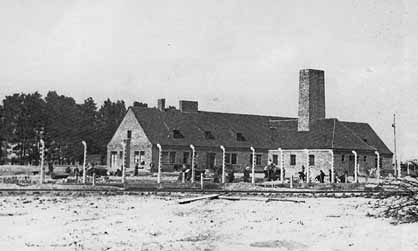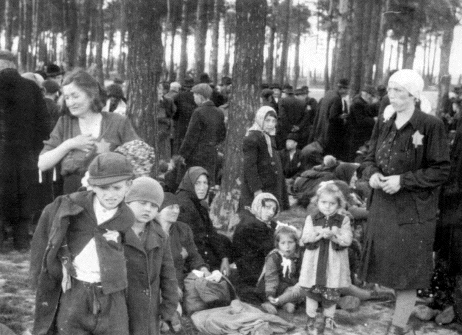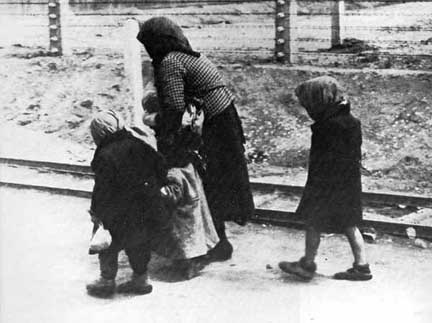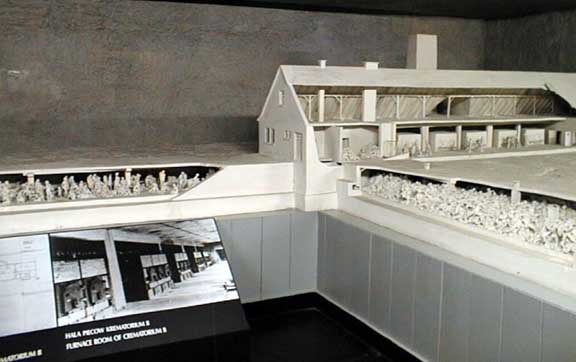Ruins of the Auschwitz Gas Chambers
Krema II and Krema III
 Ruins of Crematorium
II at Birkenau, February 1945
Ruins of Crematorium
II at Birkenau, February 1945
At the end of the main camp road, which
runs east and west through the Auschwitz II camp, also known
as Birkenau, one can see the ruins of Crematorium II on the left
and to the right, the ruins of Crematorium III. The photograph
above, taken in February 1945, shows the ruins of Crematorium
II. Today, these buildings are commonly known by their German
names: Krema II and Krema III.
A model of Crematorium III is on display
in one of the museum buildings at the Auschwitz main camp.
Below is an old picture of Crematorium
III just after the building was put into operation in the Summer
of 1943. All four of the Crematoria buildings in Birkenau were
designed by Walter Dejaco, the same architect who designed the
administration building at the entrance to the Auschwitz I camp,
and also the Central Sauna building near Crematorium IV where
the prisoners took showers.
 Crematorium III at
Birkenau, as it looked in 1943
Crematorium III at
Birkenau, as it looked in 1943
In May 1944, the railroad tracks at Auschwitz
were extended from the station into the Birkeanu camp so that
the trains carrying the Hungarian Jews could be brought inside
the camp. The old photo above shows the tracks a few feet from
the 10-foot barbed wire fence around Krema III.
According to a book from the Auschwitz
Museum, Crematorium III was blown up by the Nazis on Jan. 20,
1945, the same day that Crematorium II was destroyed. A book
from the U.S. Holocaust Museum entitled "The World Must
Know" by Michael Berenbaum says that "Soviet troops
entered Birkenau on January 18, 1945." January 18th was
the day that 60,000 prisoners were death-marched out of Auschwitz-Birkenau.
Krema II and Krema III were T-shaped
brick buildings which were mirror images. Each of the buildings
had an underground gas chamber where Jews were murdered with
Zyklon-B, a poison gas that was also used for delousing the clothing
at Auschwitz-Birkenau. Both buildings are now nothing but ruins;
they were blown up by the fleeing Nazis on Jan. 20, 1945, two
days after the camp was abandoned.
 Ruins of Crematorium
II at Birkenau, February 1945
Ruins of Crematorium
II at Birkenau, February 1945
On the ground floor of both crematoria
buildings were 5 large ovens where the bodies were cremated after
being brought up on an elevator. Each of the ovens had 3 openings,
called muffles or retorts, which means that there were actually
15 ovens which could each handle up to 3 bodies at a time.
The underground gas chambers in Krema
II and Krema III were not directly underneath the oven room,
which was the part of the building that was above ground. The
gas chamber rooms were covered only by a reinforced concrete
roof and a layer of dirt, so that Zyklon-B, which was in the
form of pellets, could be poured into the room through holes
in the roof.
In May 1944, the railroad tracks were
extended from the Auschwitz train station into the Birkenau camp
just before the Hungarian Jews began to arrive. The railroad
tracks went all the way to the western end of the Birkenau camp,
so that the Hungarian Jews could be brought directly to the gas
chambers in Krema II and Krema III, which were located near the
end of the main camp road.
The photo below shows Hungarian men,
women and children resting in the birch tree grove at the western
end of the Birkenau camp, while they wait to enter one of the
gas chambers at Birkenau.
 Hungarian women and
children in Birkenau camp, May 1944
Hungarian women and
children in Birkenau camp, May 1944
This photo is from the Auschwitz Album,
a book of photographs that was found by Lili Jacob in a concentration
camp in Germany at the end of the war. The album consists of
around 200 photos taken by an SS man at Birkenau when a transport
of 3,500 Hungarian Jews arrived in May 1944 from Carpatho-Ruthenia,
a region annexed to Hungary from the former country of Czechoslovakia
in 1939. Jacob was on this transport; she survived because she
was selected to work.
 Famous photo shows
a mother and her children walking to the gas chamber
Famous photo shows
a mother and her children walking to the gas chamber
The famous photo above was taken on the
road that runs north and south through the center of the Birkenau
camp. The woman and her children are walking to the north side
of the camp where two more gas chambers, called Krema V and Krema
IV, were located. The tracks in the photo are narrow gauge tracks
used to carry building materials to the new section of the camp,
called "Mexico," where barracks were being built for
50,000 more inmates at Birkenau.
One of the survivors of Auschwitz was
Samuel Pisar, who was first sent, at the age of 13, to the Majdanek
death camp, in August 1943, when the Bialystok ghetto in Poland
was liquidated. A few months later, he was transferred to Auschwitz-Birkenau
where he was put to work.
In an article in the Washington Post,
published on January 23, 2005, Samuel Pisar wrote the following
about his experience at Birkenau:
My labor commando was assigned to
remove garbage from a ramp near the Crematoria. From there I
observed the peak of human extermination and heard the blood-curdling
cries of innocents as they were herded into the gas chambers.
Once the doors were locked, they had only three minutes to live,
yet they found enough strength to dig their fingernails into
the walls and scratch in the words "Never Forget."
One of the Auschwitz-Birkenau prisoners,
who loaded the corpses of the murdered Jews into the Crematoria
ovens after they were killed in the gas chambers with Zyklon-B,
was Schlomo Venezia who described his work in an interview with
Adam L. Freeman, a reporter with the Bloomberg News, on December
17, 2007. According to Freeman's article, posted on the web site
www.bloomberg.com, Schlomo worked for eight months at Birkenau
in 1944, "...12 hours a day, seven days a week, cadaver
after cadaver until it became a mechanical task, like feeding
a heating furnace with cords of wood."
Schlomo Venezia wrote a memoir entitled
"Sonderkommando Auschwitz," which was originally published
in French; a new Italian version was published in 2007.
The following quote about Schlomo's story
is from Adam L. Freeman's article in the Bloomberg News on December
17, 2007:
He recalls, for example, the day he
met his father's emaciated cousin in an undressing room at the
gas chambers. Venezia offered him the only solace possible, he
writes -- some sardines and a lie that the Zyklon B would kill
him quickly.
"It was just terrible to have
to lie, but there was no way around it,'' Venezia explains. "I
tried in some way to make the horrible situation easier.''
The Sonderkommandos, as the prisoners
working at the gas chambers were known, were privy to how the
Nazis went about their butchery. Determined to keep their methods
secret, the Nazis killed members of these units at regular intervals,
making Venezia's memoir rare.
He was 20 years old at the time; he
will turn 84 on Dec. 29. His own mother was murdered at the camp
while he worked at the ovens -- one of more than 1 million Jews
killed there.
As we talk over a table of ties in
his one-room shop near the Trevi Fountain, Venezia remains almost
motionless. His Hungarian-born wife, Marika, tends to shoppers
entering through the glass door. At one point, she places a box
of coffee-filled chocolates between us.
The descendant of an old Jewish family
from Spain and Italy, Venezia was born in the northern Greek
city of Thessaloniki, where he grew up fatherless and poor, speaking
Greek, Italian and Ladino, a Spanish-Jewish dialect.
Poverty sharpened his wits, he says.
Working the black market in Nazi-occupied Greece, Venezia learned
some German, which may have saved his life. In the camp, he escaped
beatings by understanding when guards shouted out the number
tattooed on his arm: 182727.
Cutting the hair off cadavers, pulling
their gold teeth and dragging them to the furnaces became mechanical,
Venezia says, because it was the only way to stay sane. The routine
broke down only once, he recalls, when the prisoners were confronted
with the lifeless body of a woman possessing "the absolute
beauty of an ancient statue.''
She looked like "a woman in a
painting,'' Venezia says, pausing for a moment in reflection.
"Like Mona Lisa.'' Yet there was nothing to do but cremate
her.
Another day, his unit found a live
baby trying to suck its dead mother's breast among a heap of
corpses in a gas chamber. The prisoners watched without protest
as a Nazi guard unloaded his pistol into the infant.
"There were so many terrible
things that happened,'' he says. "Every day it was something
else.''
Venezia also witnessed the sometimes
absurd machinations of the Nazi bureaucracy. When one prisoner
attempted suicide, he recalls, a doctor treated his self-inflicted
wounds, making him fit to be gassed.
As the Soviet Army neared Auschwitz,
confusion swept through the camp, allowing Sonderkommandos like
Venezia and his brother to mix with other prisoners. German soldiers
marched some 5,000 survivors for days through the freezing Polish
winter until they were out of reach of Soviet troops. Then they
herded the prisoners onto trains bound for Austria, where they
were eventually freed by U.S. forces.
Venezia never talked about Auschwitz
-- even with his wife and children -- until he visited the camp
in 1992. At the time, Italy was experiencing a resurgence of
anti-Semitism, and he decided to tell his story.
Since then, he has returned to Auschwitz
46 times, often accompanying groups. He gives talks at schools
across Italy, and he spoke to Rome soccer team Lazio after striker
Paolo Di Canio was suspended for making Fascist salutes.
Another member of the Sonderkommando
who survived was Henryk Mandelbaum who arrived at Auschwitz-Birkenau
in April 1944.
The following quote is from The
Toronto Star on June 21, 2008:
Soon after a 21-year-old Henryk Mandelbaum
arrived at Auschwitz-Birkenau in April 1944, he was taken to
a gas chamber filled with the lifeless bodies of fellow Jews.
He would become accustomed to the
sight. During more than nine months as a member of the Sonderkommando,
the group of prisoners the Nazis forced to assist in the disposal
of the gassed, Mandelbaum "saw everything from beginning
to end," said Auschwitz-Birkenau museum historian Igor Bartosik
"people going into the changing rooms, he saw people
changing, he saw the moment of the gassing, the throwing of the
Zyklon into the gas chambers, he heard the screams."
Mandelbaum's daily routine: help remove
hair, gold teeth and hidden jewelry from the dead; carry them
to the crematoria; load them into the ovens.
"I thought," he said in
2006, "I was in hell. Fire and smoke were everywhere. I
had to clean the gas chambers and put the bodies in the crematoria,
or burn them outside when the extermination was in full swing
and the crematoria were not enough ... we then had to crush the
bones into powder and throw it in the river."
Sonderkommando members were habitually
executed. Fewer than 150 of more than 2,000 who served in the
group at Auschwitz-Birkenau survived. But Mandelbaum escaped
during a January 1945 "death march," then spent decades
speaking about his experience and leading group tours of the
camp.
Although Krema II was blown up by the
Nazis two days after they abandoned the camp, the underground
gas chamber is still intact and can be entered by crawling through
a hole in the roof, which was created when the building was dynamited.
The underground gas chambers were held
up by concrete columns, and originally there were also wire-mesh
columns designed to hold the Zyklon-B pellets so that they could
be retrieved after the gassing. These wire-mesh columns were
removed by the Nazis, prior to blowing up the buildings, and
can no longer be seen. The holes through which the gas was poured
are shown on aerial photos taken of the camp when the gas chambers
were in operation. The roof of the Krema III gas chamber was
completely destroyed when the building was blown up and the holes
cannot be seen today. The roof of the Krema II building was badly
damaged and the location of the holes for pouring Zyklon-B pellets
into the gas chamber cannot be found.
An aerial photo taken by the Allies in
December 1944 shows that the Germans had removed the roofs over
Crematoria II and III, as they began dismantling the interior
of the facilities in preparation for abandoning the death factory
at Birkenau.
In 1946, Rudolf Höss, the Camp Commandant
of Auschwitz-Birkenau from 1940 to 1943, was captured in northern
Germany by a British army unit called the Jewish Brigade. He
signed a confession, written in English, in which he admitted
that 9,000 Jews were gassed each day at Birkenau. After a trial
in Poland, he was hanged in front of the gas chamber building
in the Auschwitz main camp on April 16, 1947.
Here is an excerpt from the confession
of Rudolph Höss, as printed in the book entitled "Auschwitz,"
sold at the Museum. This is a description of the gassing procedure
in Krema II and Krema III.
"Those Jews selected for extermination
were brought as quietly as possible, men and women separately,
to the [buildings housing the gas chambers and] crematoria. In
the undressing room, the Sonderkommando prisoners who worked
there would tell them in their native language that they were
now going for a shower and delousing. They were instructed to
fold their clothes tidily and to make sure they remembered precisely
where they had left them so that they would be able to find them
quickly afterwards...
After undressing, the Jews were sent
into the gas chamber: it had shower installations and water pipes
so that it would look just like a shower room, but in fact it
was a gas chamber. The women and children were sent in first,
then the men, always fewer in number...
The levers locking the door were then
quickly shut tight. Fumigators who were on stand-by outside then
immediately emptied the Zyklon B down through special shafts
that opened into outlets in the ceiling...
Through a peep-hole in the door one
could see that the people standing nearest the outlets dropped
dead immediately....
Half an hour after the gas had been
introduced, the door was opened, the ventilation system was switched
on, and removal of the corpses began right away... The Sonderkommando
extracted any gold teeth, cut off the women's hair, and then
loaded the corpses on to lifts to take them up to the incinerators,
which had been stoked up in advance. Depending on the size of
the corpses, up to three could be put into an incinerator at
the same time."
 Scale model of Krema
II at the US Holocaust Memorial Museum
Scale model of Krema
II at the US Holocaust Memorial Museum
The U.S. Holocaust Memorial Museum has
a scale model of Crematorium II on display; it is shown in the
photo above.
The following quote is from a book which
I purchased at USHMM:
"Victims arrived in Crematorium
II through a stairway leading down to the undressing room. Here,
SS guards told them to surrender their valuables and undress
for delousing showers. Victims were told to remember where they
had left their clothing. Posters bearing slogans such as Cleanliness
Brings Freedom and One Louse Can Kill were designed to misrepresent
the showers as hygienic. Most victims were deceived. The undressing
room in Crematorium II could accommodate about a thousand people.
Once the victims had stripped nude, the guards herded them into
an underground gas chamber. Women and children - who were normally
the majority - always went in first. Fake shower heads in the
ceiling were intended to fool victims into believing that they
were about to shower. As soon as the chamber had been filled,
sealed and locked, SS guards poured in Zyklon B pellets through
special vents in the roof. The pellets fell to the floor, releasing
their deadly gas. Most victims died quickly. After about twenty
minutes, ventilating machines sucked out the poisonous air. When
all were dead, their bodies were pillaged and burned. Under SS
guard, prisoners hauled the corpses into an adjacent room, where
gold teeth and fillings were removed and hair was shaved off
the heads of dead women. Finally, a freight elevator lifted the
corpses to an incineration room on the ground floor. The bodies
were stuffed into ovens, three or four at a time. Crematorium
II had fifteen ovens, which could burn between forty-five and
seventy-five corpses at once, and about one thousand people in
one day."
Near Crematorium II is a low spot in
the ground which is filled with water covered by green algae.
In 1998, my guide told me that this was not the pond where the
ashes of the Jews were scattered, although some books show a
picture of this area with a caption saying that this is the site
of the ashes. When I visited again in 2005, there were four black
marble stones at the pond, which said in four languages that
this is a site where ashes from the crematorium were dumped.
On my visit in October 2005, I saw another pond near Crematorium
III with four black marble markers indicating that this was another
spot containing the ashes of the murdered Jews.
The actual pond where the ashes were
placed, according to my 1998 tour guide, was near Crematorium
IV; we passed it on the way back on another main camp road, which
ends at the former SS administration building at Birkenau. This
pond is very shallow and, when I was there in 1998, it had what
appeared to be a piece of rusted machinery sticking up in the
middle of it. When I saw the pond again in October 2005, the
rusted machinery was no longer there, but there was a similar
object in the ruins of Krema V. The water in the pond was murky
and there were no identifiable ashes around the perimeter of
it. Across the road from the pond is a low area almost as large
as the pond, which is now a bog filled with plants unlike any
others in the camp. This spot, which is near Krema V, is now
also marked as a site where ashes were dumped. According
to the book "Auschwitz," the Nazis also scattered ashes
of the gassing victims in the nearby Sola and Vistula rivers.
In a book entitled "Secretaries
of Death," a survivor named Irka Anis wrote that one night
in the middle of January 1945, she and several other female prisoners
were ordered to work for three days removing about 6,000 huge
urns containing ashes from a crematorium at Birkenau; the ashes
were loaded onto trucks and removed from the camp just before
the Nazis fled.
This page was last updated on February
2, 2008
|